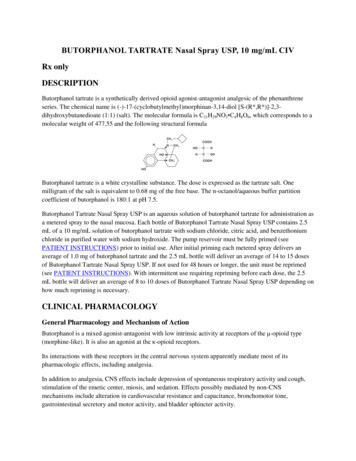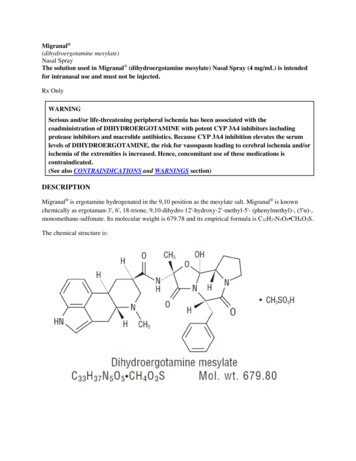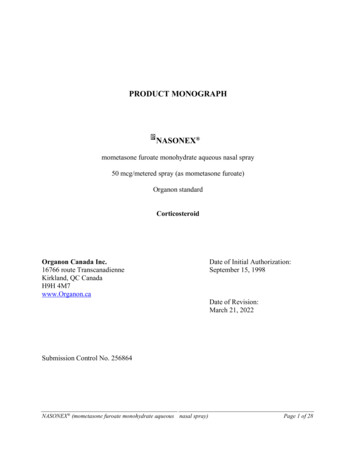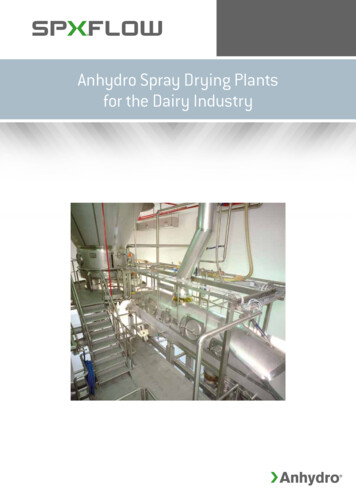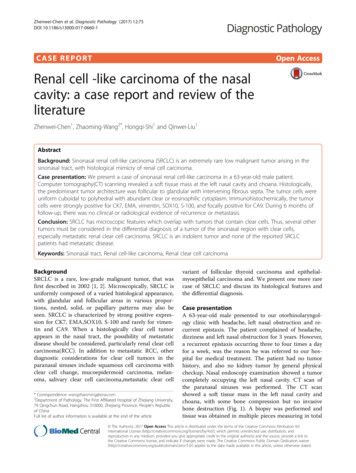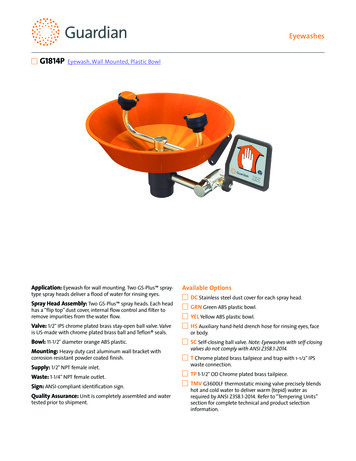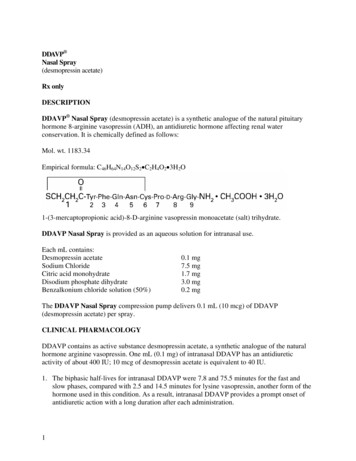
Transcription
DDAVP Nasal Spray(desmopressin acetate)Rx onlyDESCRIPTIONDDAVP Nasal Spray (desmopressin acetate) is a synthetic analogue of the natural pituitaryhormone 8-arginine vasopressin (ADH), an antidiuretic hormone affecting renal waterconservation. It is chemically defined as follows:Mol. wt. 1183.34Empirical formula: C46H64N14O12S2 C2H4O2 3H2O1-(3-mercaptopropionic acid)-8-D-arginine vasopressin monoacetate (salt) trihydrate.DDAVP Nasal Spray is provided as an aqueous solution for intranasal use.Each mL contains:Desmopressin acetateSodium ChlorideCitric acid monohydrateDisodium phosphate dihydrateBenzalkonium chloride solution (50%)0.1 mg7.5 mg1.7 mg3.0 mg0.2 mgThe DDAVP Nasal Spray compression pump delivers 0.1 mL (10 mcg) of DDAVP(desmopressin acetate) per spray.CLINICAL PHARMACOLOGYDDAVP contains as active substance desmopressin acetate, a synthetic analogue of the naturalhormone arginine vasopressin. One mL (0.1 mg) of intranasal DDAVP has an antidiureticactivity of about 400 IU; 10 mcg of desmopressin acetate is equivalent to 40 IU.1. The biphasic half-lives for intranasal DDAVP were 7.8 and 75.5 minutes for the fast andslow phases, compared with 2.5 and 14.5 minutes for lysine vasopressin, another form of thehormone used in this condition. As a result, intranasal DDAVP provides a prompt onset ofantidiuretic action with a long duration after each administration.1
2. The change in structure of arginine vasopressin to DDAVP has resulted in a decreasedvasopressor action and decreased actions on visceral smooth muscle relative to the enhancedantidiuretic activity, so that clinically effective antidiuretic doses are usually below thresholdlevels for effects on vascular or visceral smooth muscle.3. DDAVP administered intranasally has an antidiuretic effect about one-tenth that of anequivalent dose administered by injection.Human Pharmacokinetics: DDAVP is mainly excreted in the urine. A pharmacokinetic studyconducted in healthy volunteers and patients with mild, moderate, and severe renal impairment (n 24,6 subjects in each group) receiving single dose desmopressin acetate (2mcg) injection demonstrated adifference in DDAVP terminal half-life. Terminal half-life significantly increased from 3 hours innormal healthy patients to 9 hours in patients with severe renal impairment. (SeeCONTRAINDICATIONS.)INDICATIONS AND USAGECentral Cranial Diabetes Insipidus: DDAVP Nasal Spray is indicated as antidiureticreplacement therapy in the management of central cranial diabetes insipidus and for managementof the temporary polyuria and polydipsia following head trauma or surgery in the pituitaryregion. It is ineffective for the treatment of nephrogenic diabetes insipidus.The use of DDAVP Nasal Spray in patients with an established diagnosis will result in areduction in urinary output with increase in urine osmolality and a decrease in plasmaosmolality. This will allow the resumption of a more normal life-style with a decrease in urinaryfrequency and nocturia.There are reports of an occasional change in response with time, usually greater than6 months. Some patients may show a decreased responsiveness, others a shortened duration ofeffect. There is no evidence this effect is due to the development of binding antibodies but maybe due to a local inactivation of the peptide.Patients are selected for therapy by establishing the diagnosis by means of the water deprivationtest, the hypertonic saline infusion test, and/or the response to antidiuretic hormone. Continuedresponse to intranasal DDAVP can be monitored by urine volume and osmolality.DDAVP is also available as a solution for injection when the intranasal route may becompromised. These situations include nasal congestion and blockage, nasal discharge, atrophyof nasal mucosa, and severe atrophic rhinitis. Intranasal delivery may also be inappropriatewhere there is an impaired level of consciousness. In addition, cranial surgical procedures, suchas transsphenoidal hypophysectomy create situations where an alternative route of administrationis needed as in cases of nasal packing or recovery from surgery.CONTRAINDICATIONS2
DDAVP Nasal Spray is contraindicated in individuals with known hypersensitivity todesmopressin acetate or to any of the components of DDAVP Nasal Spray.DDAVP is contraindicated in patients with moderate to severe renal impairment (defined as acreatinine clearance below 50ml/min).DDAVP is contraindicated in patients with hyponatremia or a history of hyponatremia.WARNINGS1. For intranasal use only.2. DDAVP Nasal Spray should only be used in patients where orally administeredformulations are not feasible.3. Very rare cases of hyponatremia have been reported from world-wide postmarketingexperience in patients treated with DDAVP (desmopressin acetate). DDAVP is a potentantidiuretic which, when administered, may lead to water intoxication and/or hyponatremia.Unless properly diagnosed and treated hyponatremia can be fatal. Therefore, fluid restrictionis recommended and should be discussed with the patient and/or guardian. Careful medicalsupervision is required.4. When DDAVP Nasal Spray is administered, in particular in pediatric and geriatric patients,fluid intake should be adjusted downward in order to decrease the potential occurrence ofwater intoxication and hyponatremia (See PRECAUTIONS, Pediatric Use and GeriatricUse.) All patients receiving DDAVP therapy should be observed for the following signs orsymptoms associated with hyponatremia: headache, nausea/vomiting, decreased serumsodium weight gain, restlessness, fatigue, lethargy, disorientation, depressed reflexes, loss ofappetite, irritability, muscle weakness, muscle spasms or cramps and abnormal mental statussuch as hallucinations, decreased consciousness and confusion. Severe symptoms mayinclude one or a combination of the following: seizure, coma and/or respiratory arrest.Particular attention should be paid to the possibility of the rare occurrence of an extremedecrease in plasma osmolality that may result in seizures which could lead to coma.5. DDAVP should be used with caution in patients with habitual or psychogenic polydipsia whomay be more likely to drink excessive amounts of water, putting them at greater risk ofhyponatremia.PRECAUTIONSGeneral: Intranasal DDAVP at high dosage has infrequently produced a slight elevation ofblood pressure, which disappeared with a reduction in dosage. The drug should be used withcaution in patients with coronary artery insufficiency and/or hypertensive cardiovascular diseasebecause of possible rise in blood pressure.3
DDAVP should be used with caution in patients with conditions associated with fluid andelectrolyte imbalance, such as cystic fibrosis, heart failure and renal disorders because thesepatients are prone to hyponatremia.Rare severe allergic reactions have been reported with DDAVP. Anaphylaxis has been reportedrarely with intravenous and intranasal administration of DDAVP.Central Cranial Diabetes Insipidus: Since DDAVP is used intranasally, changes in the nasalmucosa such as scarring, edema, or other disease may cause erratic, unreliable absorption inwhich case intranasal DDAVP should not be used. For such situations, DDAVP Injection shouldbe considered.Information for Patients: Ensure that in children administration is under adult supervisionin order to control the dose intake. Patients should be informed that the DDAVP Nasal Spraybottle accurately delivers 50 doses of 10 mcg each. Any solution remaining after 50 doses shouldbe discarded since the amount delivered thereafter may be substantially less than 10 mcg of drug.No attempt should be made to transfer remaining solution to another bottle. Patients should beinstructed to read accompanying directions on use of the spray pump carefully before use.Fluid intake should be adjusted downward based upon discussion with the physician.Laboratory Tests: Laboratory tests for following the patient with central cranial diabetesinsipidus or post-surgical or head trauma-related polyuria and polydipsia include urine volumeand osmolality. In some cases plasma osmolality measurements may be required.Drug Interactions: Although the pressor activity of DDAVP is very low compared to theantidiuretic activity, use of large doses of intranasal DDAVP with other pressor agents shouldonly be done with careful patient monitoring. The concomitant administration of drugs that mayincrease the risk of water intoxication with hyponatremia, (e.g. tricyclic antidepressants,selective serotonin re-uptake inhibitors, chlorpromazine, opiate analgesics, NSAIDs, lamotrigineand carbamazepine) should be performed with caution.Carcinogenesis, Mutagenesis, Impairment of Fertility: Studies with DDAVP have not beenperformed to evaluate carcinogenic potential, mutagenic potential or effects on fertility.Pregnancy: Category B: Fertility studies have not been done. Teratology studies in rats andrabbits at doses from 0.05 to 10 mcg/kg/day (approximately 0.1 times the maximum systemichuman exposure in rats and up to 38 times the maximum systemic human exposure in rabbitsbased on surface area, mg/m2) revealed no harm to the fetus due to DDAVP (desmopressinacetate). There are, however, no adequate and well controlled studies in pregnant women.Because animal reproduction studies are not always predictive of human response, this drugshould be used during pregnancy only if clearly needed.Several publications of desmopressin acetate’s use in the management of diabetes insipidusduring pregnancy are available; these include a few anecdotal reports of congenital anomaliesand low birth weight babies. However, no causal connection between these events and4
desmopressin acetate has been established. A fifteen year Swedish epidemiologic study of theuse of desmopressin acetate in pregnant women with diabetes insipidus found the rate of birthdefects to be no greater than that in the general population; however, the statistical power of thisstudy is low. As opposed to preparations containing natural hormones, desmopressin acetate inantidiuretic doses has no uterotonic action and the physician will have to weigh the therapeuticadvantages against the possible risks in each case.Nursing Mothers: There have been no controlled studies in nursing mothers. A single study in apost-partum woman demonstrated a marked change in plasma, but little if any change inassayable DDAVP in breast milk following an intranasal dose of 10 mcg. It is not knownwhether this drug is excreted in human milk. Because many drugs are excreted in human milk,caution should be exercised when DDAVP is administered to a nursing woman.Pediatric Use: Central Cranial Diabetes Insipidus: DDAVP Nasal Spray has been used inchildren with diabetes insipidus. Use in infants and children will require careful fluid intakerestriction to prevent possible hyponatremia and water intoxication. (See WARNINGS.) Thedose must be individually adjusted to the patient with attention in the very young to the danger ofan extreme decrease in plasma osmolality with resulting convulsions. Dose should start at 0.05mL or less.Since the spray cannot deliver less than 0.1 mL (10 mcg), smaller doses should be administeredusing the rhinal tube delivery system. Do not use the nasal spray in pediatric patients requiringless than 0.1 mL (10 mcg) per dose.Geriatric Use: Clinical studies of DDAVP Nasal Spray did not include sufficient numbers ofsubjects aged 65 and over to determine whether they respond differently from younger subjects.Other reported clinical experience has not identified differences in responses between the elderlyand younger subjects. In general, dose selection for an elderly patient should be cautious, usuallystarting at the low end of the dosing range, reflecting the greater frequency of decreased hepatic,renal, or cardiac function, and of concomitant disease or drug therapy.This drug is known to be substantially excreted by the kidney, and the risk of toxic reactions tothis drug may be greater in patients with impaired renal function. Because elderly patients aremore likely to have decreased renal function, care should be taken in dose selection, and it maybe useful to monitor renal function. DDAVP is contraindicated in patients with moderate tosevere renal impairment (defined as a creatinine clearance below 50ml/min). (See CLINICALPHARMACOLOGY, Human Pharmacokinetics and CONTRAINDICATIONS.)Use of DDAVP Nasal Spray in geriatric patients will require careful fluid intake restriction toprevent possible hyponatremia and water intoxication. (See WARNINGS).There are reports of an occasional change in response with time, usually greater than 6 months.Some patients may show a decreased responsiveness, others a shortened duration of effect. Thereis no evidence this effect is due to the development of binding antibodies but may be due to alocal inactivation of the peptide.5
ADVERSE REACTIONSInfrequently, high dosages of intranasal DDAVP have produced transient headache and nausea.Nasal congestion, rhinitis and flushing have also been reported occasionally along with mildabdominal cramps. These symptoms disappeared with reduction in dosage. Nosebleed, sorethroat, cough and upper respiratory infections have also been reported.The following table lists the percentage of patients having adverse experiences without regard torelationship to study drug from the pooled pivotal study data for nocturnal enuresis.ADVERSE REACTIONBODY AS A WHOLEAbdominal PainAstheniaChillsHeadacheNERVOUS SYSTEMDizzinessRESPIRATORY SYSTEMEpistaxisNostril PainRhinitisDIGESTIVE SYSTEMGastrointestinal DisorderNauseaSPECIAL SENSESConjunctivitisEdema EyesLachrymation DisorderPLACEBO(N 59)%DDAVP20 mcg(N 60)%DDAVP40 mcg(N 61)%000020022225003202328003002002000220002Post Marketing: There have been rare reports of hyponatremic convulsions associated withconcomitant use with the following medications: oxybutinin and imipramine.See WARNINGS for the possibility of water intoxication and hyponatremia.OVERDOSAGESigns of overdose may include confusion, drowsiness, continuing headache, problems withpassing urine and rapid weight gain due to fluid retention. (See WARNINGS.) In case ofoverdosage, the dose should be reduced, frequency of administration decreased, or the drugwithdrawn according to the severity of the condition. There is no known specific antidote fordesmopressin acetate or DDAVP Nasal Spray.6
An oral LD50 has not been established. An intravenous dose of 2 mg/kg in mice demonstrated noeffect.DOSAGE AND ADMINISTRATIONCentral Cranial Diabetes Insipidus: DDAVP Nasal Spray dosage must be determined foreach individual patient and adjusted according to the diurnal pattern of response. Responseshould be estimated by two parameters: adequate duration of sleep and adequate, not excessive,water turnover. Patients with nasal congestion and blockage have often responded well tointranasal DDAVP. The usual dosage range in adults is 0.1 to 0.4 mL daily, either as a singledose or divided into two or three doses. Most adults require 0.2 mL daily in two divided doses.The morning and evening doses should be separately adjusted for an adequate diurnal rhythm ofwater turnover. For children aged 3 months to 12 years, the usual dosage range is 0.05 to 0.3 mLdaily, either as a single dose or divided into two doses. About 1/4 to 1/3 of patients can becontrolled by a single daily dose of DDAVP administered intranasally. Fluid restriction shouldbe observed. (See WARNINGS, PRECAUTIONS, Pediatric Use and Geriatric Use.)The nasal spray pump can only deliver doses of 0.1 mL (10 mcg) or multiples of 0.1 mL. If dosesother than these are required, the rhinal tube delivery system may be used.The spray pump must be primed prior to the first use. To prime pump, press down four times.The bottle will now deliver 10 mcg of drug per spray. Discard DDAVP Nasal Spray after 50sprays since the amount delivered thereafter per spray may be substantially less than 10 µg ofdrug.Geriatric Use: This drug is known to be substantially excreted by the kidney, and the risk oftoxic reactions to this drug may be greater in patients with impaired renal function. Becauseelderly patients are more likely to have decreased renal function, care should be taken in doseselection, and it may be useful to monitor renal function. (See CLINICALPHARMACOLOGY, Human Pharmacokinetics, CONTRAINDICATIONS, andPRECAUTIONS, Geriatric Use.)HOW SUPPLIEDDDAVP Nasal Spray is available in a 5-mL bottle with spray pump delivering 50 sprays of 10mcg (NDC 0075-2452-01). Desmopressin acetate is also available as DDAVP Rhinal Tube, arefrigerated product with 2.5 mL per bottle, packaged with two rhinal tube applicators per carton(NDC 0075-2450-01).Store at Controlled Room Temperature 20 to 25 C (68 to 77 F) [see USP]. STORE BOTTLE INUPRIGHT POSITION.Keep out of the reach of children.7
U.S. Patent Nos. 5,498,598; 5,500,413; 5,596,078; 5,674,850; 5,763,407Manufactured for:sanofi-aventis U.S. LLCBridgewater, NJ 08807Rev. July 2007 2007 sanofi-aventis U.S. LLC8
PATIENT INSTRUCTION GUIDEDDAVP Nasal Spray(desmopressin acetate)A better way to deliver DDAVPDelivering DDAVP more efficientlyYour doctor has prescribed DDAVP as antidiuretic hormone replacement therapy. Follow thedosage schedule that is specified. The convenient nasal spray pump provides an efficient, reliableway to administer your medication. It is important, however, to adhere completely to thefollowing instructions so that you will always receive a consistent dose of your medication.CAUTION: The nasal spray pump accurately delivers 50 doses of 10 micrograms each. Anysolution remaining after 50 doses should be discarded since the amount delivered thereafter peractuation may be substantially less than 10 micrograms of drug. Do not transfer any remainingsolution to another bottle. Please read the following instructions carefully before using the spraypump.Ensure that in children administration is under adult supervision in order to control thedose intake.If you accidentally deliver/administer too much of a dose, immediately telephone your doctor ora certified Regional Poison Center for advice. Possible signs of overdose may include confusion,drowsiness, continuing headache, problems with passing urine and rapid weight gain due to fluidretention.Using your DDAVP Nasal Spray Pump1. Remove protective cap.2. The spray pump must be primed prior to the first use. To prime pump, press down 4times.3. Once primed, the spray pump delivers 10 micrograms of medication each time it is pressed.To ensure dosing accuracy, tilt bottle so that dip tube inside the bottle draws from the deepestportion of the medication.CORRECT9INCORRECT
To administer a 10-microgram dose, place the spray nozzle in nostril and press the spray pumponce. If a higher dose has been prescribed, spray half the dose in each nostril. The spray pumpcannot be used for doses less than 10 micrograms or doses other than multiples of 10micrograms.4. Replace the protective cap on bottle after use. The pump will stay primed for up to one week.If the product has not been used for a period of one week, re-prime the pump by pressingonce.5. We have included a convenient check-off chart to assist you in keeping track of medicationdoses used. This will help assure that you receive 50 “full doses” of medication. Please notethat the bottle has been filled with extra solution to accommodate the initial priming activity.DDAVP Nasal Spray50-Dose 1. Retain with medication or affix in convenient location.2. Starting with dose #1, check off after each administration.3. Discard medication after 50 doses.Store at Controlled Room Temperature 20 to 25 C (68 to 77 F) [see USP].STORE BOTTLE IN UPRIGHT POSITION.Manufactured for:sanofi-aventis U.S. LLCBridgewater, NJ 08807Rev. July 2007 2007 sanofi-aventis U.S. LLC10
DDAVP Rhinal Tube(desmopressin acetate)Rx onlyDESCRIPTIONDDAVP Rhinal Tube (desmopressin acetate) is a synthetic analogue of the natural pituitaryhormone 8-arginine vasopressin (ADH), an antidiuretic hormone affecting renal waterconservation. It is chemically defined as follows:Mol. wt. 1183.34Empirical formula: C46H64N14O12S2 C2H4O2 3H2O1-(3-mercaptopropionic acid)-8-D-arginine vasopressin monoacetate (salt) trihydrate.DDAVP Rhinal Tube is provided as an aqueous solution for intranasal use.Each mL contains:Desmopressin acetate0.1 mgChlorobutanol5.0 mgSodium Chloride9.0 mgHydrochloric acid to adjust pH to approximately 4CLINICAL PHARMACOLOGYDDAVP Rhinal Tube contains as active substance desmopressin acetate, a synthetic analogueof the natural hormone arginine vasopressin. One mL (0.1 mg) of intranasal DDAVP(desmopressin acetate) has an antidiuretic activity of about 400 IU; 10 mcg of desmopressinacetate is equivalent to 40 IU.1. The biphasic half-lives for intranasal DDAVP were 7.8 and 75.5 minutes for the fast andslow phases, compared with 2.5 and 14.5 minutes for lysine vasopressin, another form of thehormone used in this condition. As a result, intranasal DDAVP provides a prompt onset ofantidiuretic action with a long duration after each administration.2. The change in structure of arginine vasopressin to DDAVP has resulted in a decreasedvasopressor action and decreased actions on visceral smooth muscle relative to the enhancedantidiuretic activity, so that clinically effective antidiuretic doses are usually below thresholdlevels for effects on vascular or visceral smooth muscle.1
3. DDAVP administered intranasally has an antidiuretic effect about one-tenth that of anequivalent dose administered by injection.Human Pharmacokinetics: DDAVP is mainly excreted in the urine. A pharmacokinetic studyconducted in healthy volunteers and patients with mild, moderate, and severe renal impairment (n 24,6 subjects in each group) receiving single dose desmopressin acetate (2mcg) injection demonstrated adifference in DDAVP terminal half-life. Terminal half-life significantly increased from 3 hours innormal healthy patients to 9 hours in patients with severe renal impairment. (SeeCONTRAINDICATIONS.)INDICATIONS AND USAGECentral Cranial Diabetes Insipidus: DDAVP Rhinal Tube is indicated as antidiureticreplacement therapy in the management of central cranial diabetes insipidus and for managementof the temporary polyuria and polydipsia following head trauma or surgery in the pituitaryregion. It is ineffective for the treatment of nephrogenic diabetes insipidus.The use of DDAVP Rhinal Tube in patients with an established diagnosis will result in areduction in urinary output with increase in urine osmolality and a decrease in plasmaosmolality. This will allow the resumption of a more normal life-style with a decrease in urinaryfrequency and nocturia.There are reports of an occasional change in response with time, usually greater than 6 months.Some patients may show a decreased responsiveness, others a shortened duration of effect. Thereis no evidence this effect is due to the development of binding antibodies but may be due to alocal inactivation of the peptide.Patients are selected for therapy by establishing the diagnosis by means of the water deprivationtest, the hypertonic saline infusion test, and/or the response to antidiuretic hormone. Continuedresponse to intranasal DDAVP can be monitored by urine volume and osmolality.DDAVP is also available as a solution for injection when the intranasal route may becompromised. These situations include nasal congestion and blockage, nasal discharge, atrophyof nasal mucosa, and severe atrophic rhinitis. Intranasal delivery may also be inappropriatewhere there is an impaired level of consciousness. In addition, cranial surgical procedures, suchas transsphenoidal hypophysectomy create situations where an alternative route of administrationis needed as in cases of nasal packing or recovery from surgery.CONTRAINDICATIONSDDAVP Rhinal Tube is contraindicated in individuals with known hypersensitivity todesmopressin acetate or to any of the components of DDAVP Rhinal Tube.2
DDAVP is contraindicated in patients with moderate to severe renal impairment (defined as acreatinine clearance below 50ml/min).DDAVP is contraindicated in patients with hyponatremia or a history of hyponatremia.WARNINGS1. For intranasal use only.2. DDAVP Rhinal Tube should only be used in patients where orally administeredformulations are not feasible.3. Very rare cases of hyponatremia have been reported from world-wide postmarketingexperience in patients treated with DDAVP (desmopressin acetate). DDAVP is a potentantidiuretic which, when administered, may lead to water intoxication and/or hyponatremia.Unless properly diagnosed and treated hyponatremia can be fatal. Therefore, fluid restrictionis recommended and should be discussed with the patient and/or guardian. Careful medicalsupervision is required.4. When DDAVP is administered, in particular, in pediatric and geriatric patients, fluid intakeshould be adjusted downward in order to decrease the potential occurrence of waterintoxication and hyponatremia (See PRECAUTIONS, Pediatric Use and Geriatric Use.) Allpatients receiving DDAVP therapy should be observed for the following signs or symptomsassociated with hyponatremia: headache, nausea/vomiting, decreased serum sodium weightgain, restlessness, fatigue, lethargy, disorientation, depressed reflexes, loss of appetite,irritability, muscle weakness, muscle spasms or cramps and abnormal mental status such ashallucinations, decreased consciousness and confusion. Severe symptoms may include one ora combination of the following: seizure, coma and/or respiratory arrest. Particular attentionshould be paid to the possibility of the rare occurrence of an extreme decrease in plasmaosmolality that may result in seizures which could lead to coma.5. DDAVP should be used with caution in patients with habitual or psychogenic polydipsia whomay be more likely to drink excessive amounts of water, putting them at greater risk ofhyponatremia.PRECAUTIONSGeneral: Intranasal DDAVP at high dosage has infrequently produced a slight elevation ofblood pressure, which disappeared with a reduction in dosage. The drug should be used withcaution in patients with coronary artery insufficiency and/or hypertensive cardiovascular diseasebecause of possible rise in blood pressure.3
DDAVP should be used with caution in patients with conditions associated with fluid andelectrolyte imbalance, such as cystic fibrosis, heart failure and renal disorders because thesepatients are prone to hyponatremia.Ensure that in children administration is under adult supervision in order to control thedose intake.Rare severe allergic reactions have been reported with DDAVP. Anaphylaxis has been reportedrarely with intravenous and intranasal administration of DDAVP.Central Cranial Diabetes Insipidus: Since DDAVP Rhinal Tube is used intranasally, changesin the nasal mucosa such as scarring, edema, or other disease may cause erratic, unreliableabsorption in which case intranasal DDAVP should not be used. For such situations, DDAVPInjection should be considered.Laboratory Tests: Laboratory tests for following the patient with central cranial diabetesinsipidus or post-surgical or head trauma-related polyuria and polydipsia include urine volumeand osmolality. In some cases plasma osmolality measurements may be required.Drug Interactions: Although the pressor activity of DDAVP is very low compared to theantidiuretic activity, use of large doses of intranasal DDAVP with other pressor agents shouldonly be done with careful patient monitoring. The concomitant administration of drugs that mayincrease the risk of water intoxication with hyponatremia, (e.g., tricyclic antidepressants, selectiveserotonin re-uptake inhibitors, chlorpromazine, opiate analgesics, NSAIDs, lamotrigine andcarbamazepine) should be performed with caution.Carcinogenesis, Mutagenesis, Impairment of Fertility: Studies with DDAVP have not beenperformed to evaluate carcinogenic potential, mutagenic potential or effects on fertility.Pregnancy Category B: Fertility studies have not been done. Teratology studies in rats andrabbits at doses from 0.05 to 10 mcg/kg/day (approximately 0.1 times the maximum systemichuman exposure in rats and up to 38 times the maximum systemic human exposure in rabbitsbased on surface area, mg/m2) revealed no harm to the fetus due to DDAVP. There are, however,no adequate and well controlled studies in pregnant women. Because animal reproduction studiesare not always predictive of human response, this drug should be used during pregnancy only ifclearly needed.Several publications of desmopressin acetate’s use in the management of diabetes insipidusduring pregnancy are available; these include a few anecdotal reports of congenital anomaliesand low birth weight babies. However, no causal connection between these events anddesmopressin acetate has been established. A fifteen year, Swedish epidemiologic study of theuse of desmopressin acetate in pregnant women with diabetes insipidus found the rate of birthdefects to be no greater than that in the general population; however the statistical power of thisstudy is low. As opposed to preparations containing natural hormones, desmopressin acetate in4
antidiuretic doses has no uterotonic action and the physician will have to weigh the therapeuticadvantages against the possible risks in each case.Nursing Mothers: There have been no controlled studies in nursing mothers. A single study inpostpartum women demonstrated a marked change in plasma, but little if any change inassayable DDAVP (desmopressin acetate) in breast milk following an intranasal dose of 10 mcg.It is not known whether this drug is excreted in human milk. Because many drugs are excreted inhuman milk, caution should be exercised when DDAVP is administered to a nursing woman.Pediatric
Nasal Spray (desmopressin acetate) Rx only DESCRIPTION DDAVP Nasal Spray (desmopressin acetate) is a synthetic analogue of the natural pituitary hormone 8-arginine vasopressin (ADH), an antidiuretic hormone affecting renal water conservation. It is chemically defined as follows: Mol. wt. 1183.34 Empirical formula: C46H64N14O12S2 C2H4O2 3H2O
